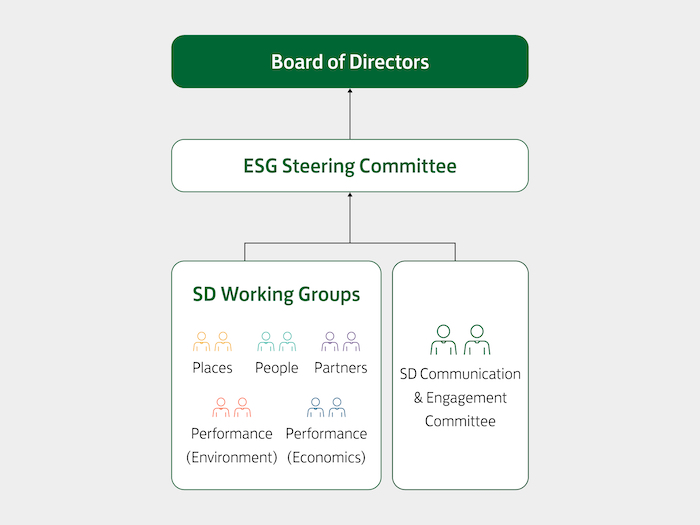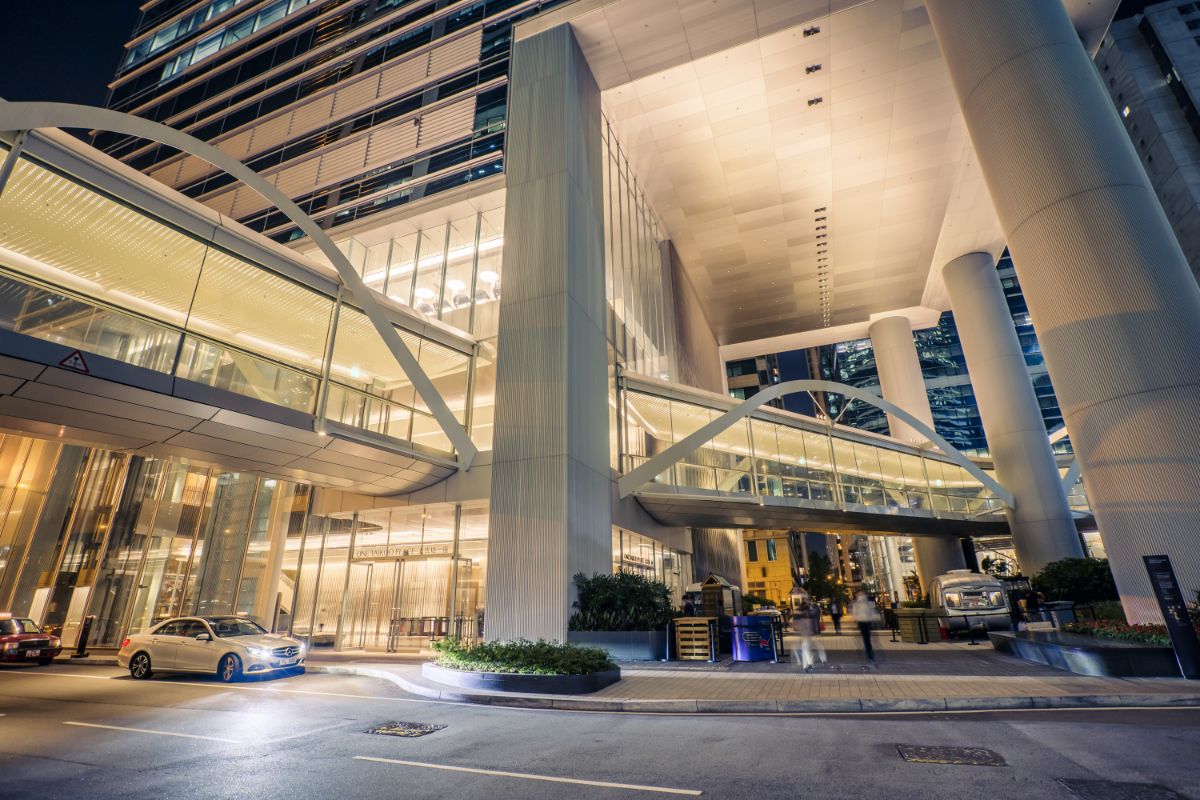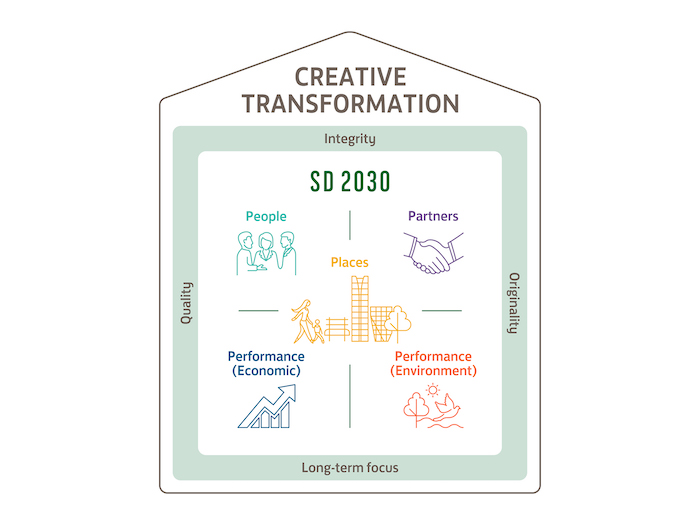Our Stakeholder Engagement Framework
As set out in our SD 2030 Strategy, communication and engagement with employees, investors, tenants, customers, suppliers, regulators, NGOs, community representatives, and our many other stakeholders is an integral part of Swire Properties’ daily operations.
We regularly engage with our stakeholders to understand their priorities, expectations and perceptions regarding SD issues. When we first introduced our SD 2030 Strategy in 2016, we engaged extensively with senior managers and employees from across the business and consulted external sustainability experts. Our SD Communication and Engagement Committee continues to gather the support of our employees and other stakeholders to further integrate SD 2030 across our business.
In the past, we measured the materiality of a particular topic based on the level of importance to stakeholders. This was based on feedback from external stakeholders, and the importance to our business continuity and development as reflected by feedback from internal stakeholders. In 2023, we embraced the concept of double materiality, taking into consideration the issues’ impacts on the organisation (internal materiality) and the organisation’s impact on these issues (external materiality). This approach considers the interconnectedness between our business activities, stakeholder expectations and the environment. It enables us to identify and prioritise material issues that may have significant consequences for our stakeholders, while also aligning with long-term sustainability goals and addressing systemic risks.
Embracing this more robust and data-driven approach to materiality will strengthen our ability to proactively manage risks, seize opportunities and foster sustainable practices that contribute to the wellbeing of our stakeholders, our organisation and the world at large.
The development of this double materiality approach is discussed in the Our Evolving Approach to Stakeholder Materiality section.
Our Stakeholders
GRI 102-40, 102-42, 102-43
Swire Properties’ stakeholders comprise internal and external interest groups that have a significant impact on our business, or that experience significant impacts from our operations. We regularly engage with these stakeholders through the appropriate channels. While the stakeholder groups remained the same in 2023, the number of stakeholders increased.
Stakeholder Groups and Methods of Engagement

Employee Groups

Community / NGOs

Tenants

Customers / Consumers

Suppliers

Regulators / Government

Industry Experts / Academia

Joint Venture Partners

Shareholders and Investors

Media
0 / 10
Our Evolving Approach to Stakeholder-driven Materiality
GRI 3-1, 3-2
HKEX Mandatory Disclosure Requirement
HKEX Mandatory Disclosure Requirement
In 2020, we initiated a materiality review to understand our stakeholders’ perceptions of the progress of our SD 2030 Strategy and their evolving expectations and priorities for the future. These perceptions helped further align our business practices, improved our decision-making and accountability, and guided the refinement of our strategy and focus areas in response to the latest local, regional and global developments.
In 2021, we continued this process, adopting a combined qualitative and quantitative approach to assessing materiality. Throughout the COVID-19 pandemic, we gathered stakeholders’ feedback to gain greater understanding of the pandemic’s effects on their businesses, the real estate industry and our operations. The findings provided insights into ways of providing support to our stakeholders during challenging times.
Swire Properties is continuing to build on and refine our approach to materiality. In 2023, we began an in-depth materiality assessment and stakeholder engagement exercise based on the concept of double materiality. Led by an independent consultant, the five-phase, mixed-method project aimed to deliver a broad and deep range of insights.
Phase 1: Impact Metrics and Megatrends
The first phase was a comprehensive review to identify key issues and metrics. We first revisited previous materiality assessment metrics and reviewed how well we had addressed the previously identified material issues.
We then identified industry sector, local and global megatrends to understand the larger trends shaping our industry and the world, and to anticipate upcoming challenges and opportunities.
Megatrends
Megatrend | Description | Significance to Swire Properties |
|---|---|---|
New legislation and reporting measures | Global recognition of the climate crisis has led to countries setting net-zero commitments and passing legislation to meet targets. | Regulatory pressures and investor attention are driving an increased focus on ESG disclosures and solutions in the real estate sector, pushing the sector towards more sustainable and energy-efficient practices. |
Growing focus on biodiversity and nature | There is a growing focus on the need for businesses to create action plans to mitigate human influence on climate, biodiversity and nature. | The real estate sector is a significant contributor to biodiversity loss. While nature-related impacts are lower for companies investing in urban areas, the biodiversity impact associated with procuring building materials across supply chains must be considered. |
Accelerating to net-zero | Companies moving into the net-zero energy transition will outperform others in the medium term as economies adapt and investor preferences shift towards more sustainable offerings. | Buildings account for about 39% of global energy-related carbon emissions. As such, the built environment has a critical role to play in reducing these emissions through innovative technologies and approaches. |
Building climate resilience | With hundreds of cities predicted to suffer from extreme heat and sea level rises by 2050, high-level collaboration is happening across cities, regions and industries to build more climate-resilient communities. | Delaying action on climate resilience and adaptation will lead to reduced building performance, a higher potential for damage and larger insurance premiums. Investing in resilience provides opportunities to innovate and strengthen communities and social cohesion. |
Improving circularity in design and use | The most sustainably progressive cities and companies consider how to address circularity through the full lifecycle of a building, including construction, maintenance and demolition. | Construction waste and operational waste account for a huge proportion of total waste disposal. Designing out waste across the building lifecycle and emphasising durability, recycling and circular thinking in operations and across the supply chain are becoming increasingly important. |
Tackling social inequality | Inequality – a lack of diversity, equity and inclusion – is a critical challenge that erodes social cohesion, diminishes trust in key institutions, fuels civil and personal conflict, and threatens economic growth. | As stakeholders’ social inclusion expectations increase, it will become more important to level up from equality measures that focus on acquiring and retaining talent, and move towards those that focus on workplace inclusivity, respond to societal issues like racism and make services equitable and accessible to all communities. |
Cost-of-living crisis redefines value | A combination of the current cost-of-living crisis and post-pandemic changes in consumer behaviour, such as the increased demand for flexible workspaces and a lower willingness to commute, has led to a re-evaluation of what households and businesses can afford, presenting a challenge to all industries. | The trend for flexible office spaces and short leases is remaining, as the COVID-19 pandemic changed how, where and why we use different types of properties. There is also a broader demand that wellbeing should be a central part of the real estate value proposition, including components such as access to nature, accessible public spaces, natural light, and improved indoor air quality. This increases the importance of placemaking – creating walkable, liveable and vibrant communities. |
More active supply chain management | There are now high expectations that companies understand and proactively manage their full supply chain. Each party is responsible for agreeing and aligning on key issues from working conditions to carbon emissions. Reporting requirements increasingly require the disclosure of Scope 3 emissions, meaning that the entire supply chain must be addressed. | Supply chain volatility, poor construction industry labour conditions and a growing focus on Scope 3 emissions make supply chain collaboration, coordination and alignment essential, as each function must measure, access and track the same ESG data. Capturing real-time operational data will improve transparency and visibility across the entire supply chain, while green product certifications help assure effective supply chain practices across the value chain. |
Phase 2: One-to-one Stakeholder Interviews
Twenty-two in-depth interviews were conducted, engaging a wide range of stakeholders including our senior management, business partners, industry associations, tenants, investors, and academia. The interviews provided valuable insights into the strengths that we may leverage, key focus areas, areas of opportunity, and the current and future sustainability landscape.
Phase 3: Online Stakeholder Surveys
Employees, business partners, industry associations, tenants, investors, academia, peers, media, and government representatives were invited to provide feedback through an online survey. The survey asked about stakeholder views on the relative importance of different ESG issues for Swire Properties, how well we are performing on these issues, and the Company's future priorities. The survey received 591 responses.
Phase 4: Analysis and Reporting
The data collected from the one-to-one interviews, online surveys and findings from industry benchmarks, indices ratings and disclosure frameworks were analysed.
This analysis informed the development of our new double materiality matrix, a visual representation of issues that are important to stakeholders, the issues’ level of impact on us, and our impact on these issues. This matrix provides a comprehensive understanding of how these issues and metrics impact the Company inwardly and outwardly at present and in the future and will inform the direction of our SD 2030 Strategy. The findings were also shared with our Risk department and will inform our CRR and ERM process processes.
Phase 5: Internal Validation and Engagement
A validation workshop was conducted with senior management to present and endorse the double materiality findings. The results were then presented to the ESG Steering Committee and the Board and will be integrated into the Company’s strategic planning and decision-making processes in the future. The findings were also shared with all governance bodies responsible for overseeing sustainability and ESG-related matters.
Double Materiality Matrix
Please select (single option):
Tier 1 Issues
(the most important material issues with the highest potential impact on business success)
Tier 2 Issues
(important material issues with a high potential impact on business success)
Tier 3 Issues
(relatively less important material issues, as perceived by stakeholders, that can impact business success)
Click on the Materiality Matrix to view and learn more about the material issues in each Tier
Tier 1 Issues
(the most important material issues with the highest potential impact on business success)
Tier 2 Issues
(important material issues with a high potential impact on business success)
Tier 3 Issues
(relatively less important material issues, as perceived by stakeholders, that can impact business success)
Places
People
Partners
Performance (Environment)
Performance (Economic)
All Pillars
The top material issues in the matrix are consistent with the focus areas of our SD 2030 Strategy and have been addressed in this report in accordance with the relevant Global Reporting Initiative Standards. The matrix will also inform future reviews of our SD 2030 Strategy, allowing us to continuously drive meaningful impact within the organisation and deliver positive value to our stakeholders.
Discussion of Top Material Issues
Material Issues | Internal Materiality | External Materiality |
|---|---|---|
Green Building | Implementing green building strategies can lead to operational cost savings through reduced energy and water consumption and lower waste management expenses. Green buildings can generate financial opportunities by attracting high-quality tenants that prioritise ESG matters. Investing in green building initiatives allows us to comply with evolving environmental regulations and standards, ensuring long-term compliance and reducing the risk of sanctions or legal issues. | Stakeholders, including tenants and investors, are becoming increasingly committed to decarbonisation and usually have their own decarbonisation targets in place. This has created a positive demand for real estate solutions from like-minded companies that can help them achieve their targets. Green building practices and certifications, such as LEED, are crucial to external stakeholders as they demonstrate a commitment to sustainability. |
Climate | Swire Properties takes proactive measures to mitigate climate risks and build climate resilience across our portfolios. We incorporate sustainable design features into new developments, adopt adaptive measures for extreme weather events, and implement disaster preparedness plans. We believe this can enhance climate resilience, minimise potential disruptions, improve occupant safety and wellbeing, and safeguard assets. | Our stakeholders, including tenants, investors and the community, are concerned about climate resilience as they recognise the increasing risks associated with climate change such as extreme weather events, rising sea levels and extreme temperature events. Stakeholders value efforts to enhance infrastructure resilience and adopt adaptive measures to ensure business continuity in the face of climate-related challenges. |
Energy Efficiency | Swire Properties strives to reduce energy consumption in all our portfolios. We invest in best-in-class energy efficiency, perform retro-commissioning and technical upgrades across our portfolios, extensively apply innovative low-carbon and energy-efficient technologies, and are increasing our adoption of renewable energy. Energy efficiency efforts are crucial to delivering on our near-term 1.5°C-aligned science-based targets and transitioning to net-zero before 2050. | Energy efficient operations bring environmental and economic benefits. Stakeholders, including tenants, regulators, and environmental groups, expect organisations to reduce energy consumption and greenhouse gas emissions. Energy efficient buildings contribute to mitigating climate change, help lower operational costs and enhance overall sustainability performance. |
Decarbonisation | Swire Properties was the first real estate company in Hong Kong and the Chinese Mainland to support the Business Ambition for 1.5°C campaign and set ambitious 1.5°C-aligned science-based targets to fight climate change. We have committed to achieving net-zero emissions by 2050 and support Hong Kong’s carbon neutrality pledge. The transition to net zero will bring us closer to this commitment by saving costs through energy efficiency improvements and by providing opportunities for innovation and market differentiation. Through proactively addressing decarbonisation, we can future-proof our operations, mitigate regulatory risks and position ourselves as an industry leader in sustainable development. | Investors and regulatory bodies are increasingly concerned about organisations’ carbon footprints. Companies are expected to actively reduce greenhouse gas emissions and transition to low-carbon practices in line with the Paris Agreement. Exploring technological innovations, digitalisation, deploying energy-efficient technologies, and increasing renewable energy adoption are crucial if organisations are to align with global climate goals and demonstrate environmental leadership. |
Occupational Health & Safety | Health and safety is an indispensable part of our business. We are committed to providing and maintaining a healthy and safe environment for all our employees, customers, contractors and members of the community during their association with the Company. Occupational health and safety directly impact the wellbeing of employees and the overall productivity and reputation of the Company. Prioritising a safe and healthy work environment helps minimise accidents, injuries and potential liabilities. It also fosters employee satisfaction, engagement and retention, leading to higher productivity and reduced turnover costs. | Employees, local communities, business partners and regulatory bodies consider occupational health and safety to be important. They expect organisations to prioritise the wellbeing of their employees and those with whom they work by providing safe working conditions. Demonstrating a strong commitment to occupational health and safety protects employees, enhances an organisation’s reputation, attracts and retains talent, and reduces the risk of legal and reputational issues. It is a fundamental aspect of responsible and sustainable business practices. |
List of Material Issues
Level of importance increased compared to the previous stakeholder engagement exercise
Level of importance decreased compared to the previous stakeholder engagement exercise
Level of importance remained broadly the same compared to the previous stakeholder engagement exercise
Level of likelihood that the material issue will become increasingly important in the future
See More In
NaN / 3



